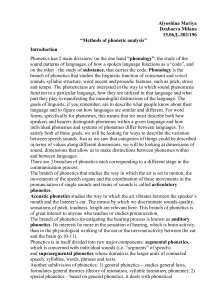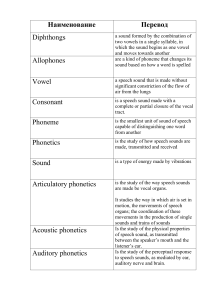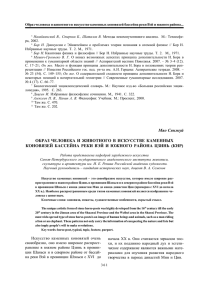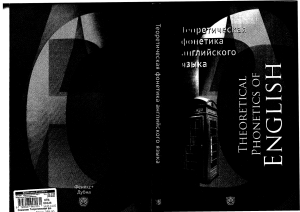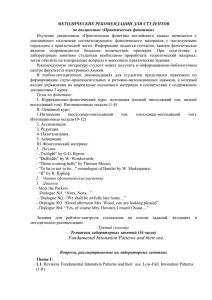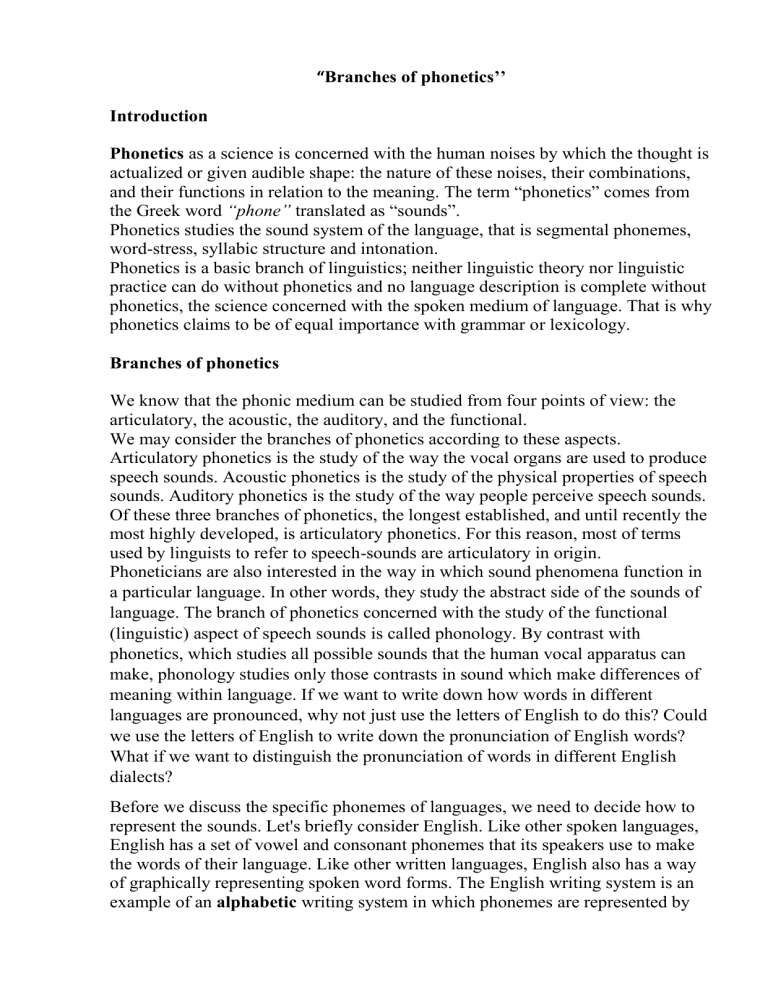
“Branches of phonetics’’ Introduction Phonetics as a science is concerned with the human noises by which the thought is actualized or given audible shape: the nature of these noises, their combinations, and their functions in relation to the meaning. The term “phonetics” comes from the Greek word “phone” translated as “sounds”. Phonetics studies the sound system of the language, that is segmental phonemes, word-stress, syllabic structure and intonation. Phonetics is a basic branch of linguistics; neither linguistic theory nor linguistic practice can do without phonetics and no language description is complete without phonetics, the science concerned with the spoken medium of language. That is why phonetics claims to be of equal importance with grammar or lexicology. Branches of phonetics We know that the phonic medium can be studied from four points of view: the articulatory, the acoustic, the auditory, and the functional. We may consider the branches of phonetics according to these aspects. Articulatory phonetics is the study of the way the vocal organs are used to produce speech sounds. Acoustic phonetics is the study of the physical properties of speech sounds. Auditory phonetics is the study of the way people perceive speech sounds. Of these three branches of phonetics, the longest established, and until recently the most highly developed, is articulatory phonetics. For this reason, most of terms used by linguists to refer to speech-sounds are articulatory in origin. Phoneticians are also interested in the way in which sound phenomena function in a particular language. In other words, they study the abstract side of the sounds of language. The branch of phonetics concerned with the study of the functional (linguistic) aspect of speech sounds is called phonology. By contrast with phonetics, which studies all possible sounds that the human vocal apparatus can make, phonology studies only those contrasts in sound which make differences of meaning within language. If we want to write down how words in different languages are pronounced, why not just use the letters of English to do this? Could we use the letters of English to write down the pronunciation of English words? What if we want to distinguish the pronunciation of words in different English dialects? Before we discuss the specific phonemes of languages, we need to decide how to represent the sounds. Let's briefly consider English. Like other spoken languages, English has a set of vowel and consonant phonemes that its speakers use to make the words of their language. Like other written languages, English also has a way of graphically representing spoken word forms. The English writing system is an example of an alphabetic writing system in which phonemes are represented by characters or combinations of characters. But, for various historical reasons, the English writing system does this very imperfectly. Consider the words way, weigh, wait, and wake. These words share the same vowel phoneme, but it is spelled in four different ways. That is, a single phoneme may be represented using different letters or combinations of letters. Now consider the words bother, brother, border, and voter. These words share the letter o, but it represents four different vowels, each a different phoneme. That is, a single letter may represent multiple phonemes. We can conclude two things from this. We must be careful not to confuse sounds with letters; the letter o is not a vowel, though it is used to represent vowels. We cannot rely on English spelling when we are concerned with the pronunciation of English words. Because we will need a way to represent the phonemes of English and other languages unambiguously, we must rely on a set of symbols for this that are not used quite like the alphabets of any alphabetic writing systems. Symbols representing the basic sounds, or phones, of spoken languages, are called phonetic symbols. Linguists use a set of phonetic symbols called the International Phonetic Alphabet (IPA). The symbols in the IPA are based on the characters in the Roman alphabet, which is also the basis for the writing systems of many languages, including English, Spanish, Lingala, and Tzeltal. The IPA is overseen by the International Phonetics Association. Here is a full chart of the IPA symbols that you can click on to hear some of the sounds. Note that you probably won't understand this table until after you've studied this section, the next one on English consonants, and the one after than on consonants in other languages. Besides the four branches of phonetics described above, there are other divisions of the science. We may speak of general phonetics and the phonetics of a particular language (special or descriptive phonetics). General phonetics studies all the sound-producing possibilities of the human speech apparatus and the ways they are used for purpose of communication. The phonetics of a particular language studies the contemporary phonetic system of the particular language, i.e. the system of its pronunciation, and gives a description of all the phonetic units of the language. Descriptive phonetics is based on general phonetics. Linguists distinguish also historical phonetics whose aim is to trace and establish the successive changes in the phonetic system of a given language (or a language family) at different stages of its development. Historical phonetics is a part of the history of language. Closely connected with historical phonetics is comparative phonetics whose aims are to study the correlation between the phonetic systems of two or more languages and find out the correspondences between the speech sounds of kindred languages. Phonetics can also be theoretical and practical. At the faculties of Foreign Languages in this country, two courses are introduced: Practical, or normative, phonetics that studies the substance, the material form of phonetic phenomena in relation to meaning. Theoretical phonetics, which is mainly concerned with the functioning of phonetic units in language. This dichotomy is that which holds between theoretical and applied linguists. Briefly, theoretical linguistics studies language with a view to constructing theory of its structure and functions and without regard to any practical applications that the investigation of language might have. Applied linguistics has as its concerns the application of the concepts and findings of linguistics to a variety of practical tasks, including language teaching. All the branches of phonetics are closely connected not only with one another but also with other branches of linguistics. This connection is determined by the fact that language is a system whose components are inseparably connected with one another. Phonetics is also connected with many other sciences. Acoustic phonetics is connected with physics and mathematics. Articulatory phonetics is connected with physiology, anatomy, and anthropology. Historical phonetics is connected with general history of the people whose language is studied; it is also connected with archaeology. Phonology is connected with communication (information) theory, mathematics, and statistics. Conclusion Every language has its own intonation, or speech melody. Intonation helps to recognize the language that you hear in the same way as the melody of a song helps to recognize the song that you hear. If you change the melody of a song, your listener will have a hard time recognizing and understanding the song you are singing. The same about intonation: if you speak English with Russian intonation, your listener will have a problem understanding what you are saying.
